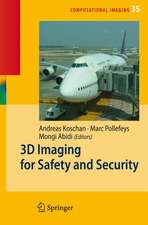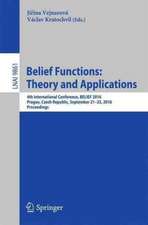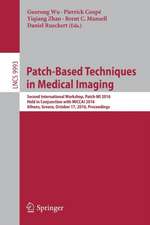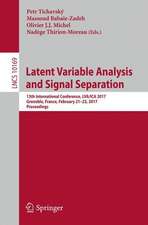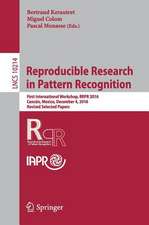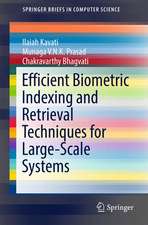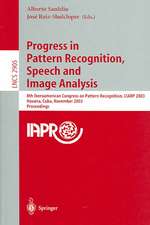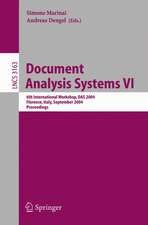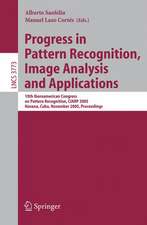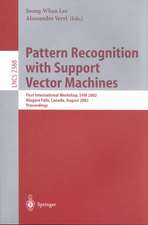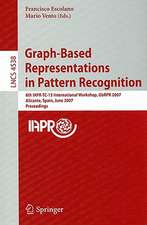Syntactic and Structural Pattern Recognition: NATO ASI Subseries F:, cartea 45
Editat de Gabriel Ferrate, Theo Pavlidis, Alberto Sanfeliu, Horst Bunkeen Limba Engleză Paperback – 14 dec 2011
Din seria NATO ASI Subseries F:
- 20%
 Preț: 650.27 lei
Preț: 650.27 lei - 20%
 Preț: 668.55 lei
Preț: 668.55 lei - 20%
 Preț: 992.44 lei
Preț: 992.44 lei - 18%
 Preț: 1239.19 lei
Preț: 1239.19 lei - 20%
 Preț: 1922.81 lei
Preț: 1922.81 lei - 20%
 Preț: 654.37 lei
Preț: 654.37 lei - 18%
 Preț: 1234.00 lei
Preț: 1234.00 lei - 20%
 Preț: 709.78 lei
Preț: 709.78 lei - 20%
 Preț: 656.03 lei
Preț: 656.03 lei - 18%
 Preț: 1854.94 lei
Preț: 1854.94 lei - 20%
 Preț: 374.97 lei
Preț: 374.97 lei - 20%
 Preț: 991.94 lei
Preț: 991.94 lei - 20%
 Preț: 671.02 lei
Preț: 671.02 lei - 20%
 Preț: 1925.96 lei
Preț: 1925.96 lei - 20%
 Preț: 994.73 lei
Preț: 994.73 lei -
 Preț: 389.49 lei
Preț: 389.49 lei - 20%
 Preț: 657.99 lei
Preț: 657.99 lei - 20%
 Preț: 655.20 lei
Preț: 655.20 lei - 18%
 Preț: 1225.31 lei
Preț: 1225.31 lei - 18%
 Preț: 952.09 lei
Preț: 952.09 lei - 20%
 Preț: 332.06 lei
Preț: 332.06 lei - 20%
 Preț: 1284.47 lei
Preț: 1284.47 lei - 20%
 Preț: 644.81 lei
Preț: 644.81 lei -
 Preț: 395.85 lei
Preț: 395.85 lei - 18%
 Preț: 1221.07 lei
Preț: 1221.07 lei - 15%
 Preț: 643.34 lei
Preț: 643.34 lei - 20%
 Preț: 645.47 lei
Preț: 645.47 lei - 20%
 Preț: 1282.98 lei
Preț: 1282.98 lei - 20%
 Preț: 656.36 lei
Preț: 656.36 lei - 20%
 Preț: 1283.31 lei
Preț: 1283.31 lei - 20%
 Preț: 1924.15 lei
Preț: 1924.15 lei - 20%
 Preț: 362.24 lei
Preț: 362.24 lei
Preț: 345.44 lei
Preț vechi: 431.80 lei
-20% Nou
Puncte Express: 518
Preț estimativ în valută:
66.11€ • 68.76$ • 54.58£
66.11€ • 68.76$ • 54.58£
Carte tipărită la comandă
Livrare economică 15-29 aprilie
Preluare comenzi: 021 569.72.76
Specificații
ISBN-13: 9783642834646
ISBN-10: 3642834647
Pagini: 492
Ilustrații: XV, 471 p.
Dimensiuni: 170 x 244 x 26 mm
Greutate: 0.78 kg
Ediția:Softcover reprint of the original 1st ed. 1988
Editura: Springer Berlin, Heidelberg
Colecția Springer
Seria NATO ASI Subseries F:
Locul publicării:Berlin, Heidelberg, Germany
ISBN-10: 3642834647
Pagini: 492
Ilustrații: XV, 471 p.
Dimensiuni: 170 x 244 x 26 mm
Greutate: 0.78 kg
Ediția:Softcover reprint of the original 1st ed. 1988
Editura: Springer Berlin, Heidelberg
Colecția Springer
Seria NATO ASI Subseries F:
Locul publicării:Berlin, Heidelberg, Germany
Public țintă
ResearchCuprins
I. Matching and Parsing I.- A string correction method based on the context-dependent similarity.- An error-correcting parser for a context-free language based on the context-dependent similarity.- Ordered structural matching.- II. Matching and Parsing II.- A parsing algorithm for weighted grammars and substring recognition.- Computing the minimum error distance of graphs in 0 (n3) time with precedence graph grammars.- A unified view on tree metrics.- III. Applications I.- Problems in recognition of drawings.- Application of structural pattern recognition in histopathology.- Applications of multidimensional search to structural feature identification.- IV. Grammatical Inference and Clustering.- Learning from examples in sequences and grammatical inference.- An efficient algorithm for the inference of circuit-free automata.- Voronoi trees and clustering problems.- V. Image Understanding.- Hough-space decomposition for polyhedral scene analysis.- Running efficiently arc consistency.- Smith: an efficient model-based two dimensional shape matching technique.- Training and model generation for a syntactic curve network parser.- VI. Applications II.- Knowledge-based computer recognition of speech.- Computers viewing artists at work.- Face recognition from range data by structural analysis.- Cryptosystems for picture languages.- VII. Hybrid Approaches I.- Hybrid approaches.- An AI-structural approach to edge detection.- Building hierarchies-an algorithmic approach.- VIII. Hybrid Approaches II.- Combining logic based and syntactic techniques: a powerful approach.- A syntactic approach to planning.- IX. Working Sessions.- Working Group A: 2D and 3D Image Understanding.- Working Group B: Waveform and Speech Recognition.- Working Group C: Hybrid Techniques.- Working Group D: Models and Inference.- X. Panel.- Artificial Intelligence Versus Syntactic Techniques: Theoretical and Practical Issues.- XL List of Participants.

